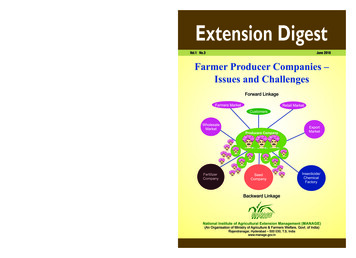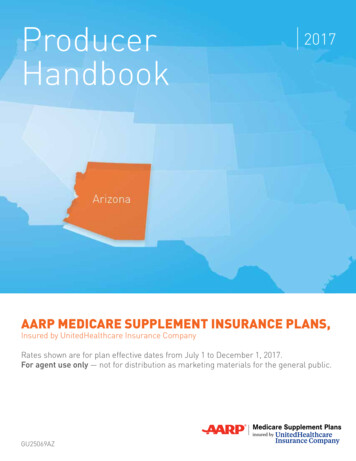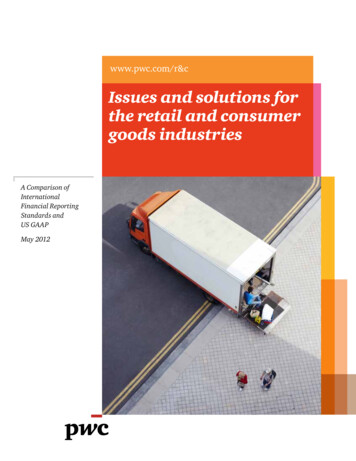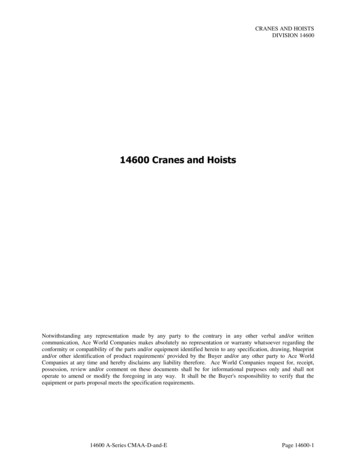
Transcription
Farmer Producer Companies – Issues and Challengesiv
Farmer Producer Companies – Issues and ChallengesFarmer Producer Companies –Issues and ChallengesNational Institute of Agricultural Extension Management(An Organization of Ministry of Agriculture & Farmers Welfare, Government of India)Rajendra Nagar, Hyderabad – 500 030, Telanganai
Farmer Producer Companies – Issues and ChallengesPublished by the National Institute of Agricultural Extension Management (MANAGE)(An Organisation of the Ministry of Agriculture and Farmers Welfare, Govt. of India)Rajendranagar, Hyderabad – 500030, Telangana State, India. MANAGE, 2018Authors:Dr. B.K. PatyDirector (OSPM)National Institute of Agricultural Extension Management (MANAGE)Rajendranagar, Hyderabad – 500030, Telangana, India.e-mail: bkpaty@manage.gov.inDr.K.C.GummagolmathDeputy Director (M&E)National Institute of Agricultural Extension Management (MANAGE)Rajendranagar, Hyderabad – 500030, Telangana, India.e-mail: kcgum@manage.gov.inAbout the Publication:Extension Digest is a publication from the National Institute of Agricultural Extension Management(MANAGE). The purpose is to disseminate information on extension systems and practices,research on extension methods, efficient organisation of technology transfer and current concernsin the area of agriculture.June 2018Disclaimer: The views expressed in this document are of the authors and not necessarily thoseof MANAGE.ii
Farmer Producer Companies – Issues and ChallengesForewordI am glad to inform that “Extension Digest” is revived after a gap of 16 years with a timely themeVariousinstitutional interventions started by government, private and civil society organizations, have triedon “Harnessing Social Media for Agricultural Development”. Social Media have now become anto linksmallholdersto oftheinput and/or outputmarkets.Severalattempts have been made to aggregateimportantmeanscommunicationfor everyonein allthe sectors.the farmers into different forms of groups. However, the success achieved has been limited. These includeThese toolsare impactingthegroups,agriculturesector tyinterestgroups,producernew opportunities for Agricultural Research, Extension, Education and Marketing Organisationsto communicate and collaborate and enabling exchange of information and networking amongof scale. Group members are able to leverage collective strength and bargaining power to access inputs,agricultural officers and farmers.producer companies, etc. There is a need for aggregation of farmers in order to benefit from economiesservices and appropriate technologies leading to reduction in transaction costs.More importantly, Social Media platforms such as Facebook, LinkedIn, Blogs, Twitter, WhatsApp,YouTube, Skype etc., are not only enabling scientists and extension professionals share informationinstrument of Farmer Producer Company (FPC), registered under Companies Act, 1956 is emerging as anbut also empowering farmers to link to markets and consumers for better profits. Social Media alsoeffectiveFarmerProducertoOrganization(FPO)to farmcaterpractices,to the aggregationof greatfarmersat thegrassprovideopportunityfarmers to sharetheirchallengesneedsand theservicetheyroot level.The inmainobjectivefarmers into member-owned producer companies, or FPCs, isare doingorderto feed ofthemobilizingpopulation.Recently, a new model of aggregation in the form of Farmer Producer Company (FPC) has evolved. Theto enhance production, productivity and profitability of agriculturists, especially small farmers in the country.There is a need to harness Social Media for agricultural development by all actors especially theagricultural extension professionals who play a major role in disseminating technologies andmodels. FPCs offer a wide range of benefits compared to other formats of aggregation of the farmers.innovations to farmers. It is necessary to equip extension personnel on Social Media concepts,Its mainactivitiesandconsistof ng,handling,applicationscommunicationstrategiesin orderto harnessSocial Mediagrading,for eirbenefit.agricultural information.It takes care of the entire supply chain and hence is a distinguished model compared to other aggregationIt provides for sharing of profits/benefits among the members.This issue of the Extension Digest focuses on Social media and application in agriculture and alliedThis sectorsissue ofandthe alsoExtensionfocuseson the rationalefor FarmerProducershares Digestcases whichdemonstratethe powerof SocialMedia Organization/Companies;in effective sharing ofconceptand genesisof FPOs/FPCs;policy issuesfor promotion of FPOs/FPCs and presents some Successagriculturalinformationand knowledgeand networking.stories of these Organizations.I am sure that this Extension Digest issue will be helpful for all actors in agriculture sector in generaland agricultural extension professionals in particular in understanding and using Social Media foragricultural development.Smt. V. Usha Rani, IASDirectorGeneral,MANAGESmt.V. UshaRani, IASDirector General, MANAGEiii
Farmer Producer Companies – Issues and Challengesiv
Farmer Producer Companies – Issues and ChallengesFarmer Producer Companies –Issues and ChallengesSince 1950, the share of agriculture in the country’s Gross Domestic Product (GDP) declinedsubstantially but there was only marginal decline in the number of persons dependent on agriculture.The Agriculture sector currently contributes nearly 14 per cent of total GDP, while still accounts forabout 55 per cent of total employment (GoI, 2014). India had over 138 million farm holdings as per theAgricultural Census, 2011. Of this, about 92.8 million were marginal farm holdings i.e. having individualoperational land holding of less than 1 hectare while another about 24.8 million were small farm holdingswith individual operational land holding size less than 2 hectares. Therefore, the marginal and smallfarm holdings together accounted for a whopping 85.0 percent of the total farm holdings in India in2010-11.The size of operational holdings in India is continuously declining with every successive generation.The situation has raised serious question on the survivability of these small holders (Pandey, et. al.,2010). On the other hand, the rapid increase in population coupled with substantive increase in incomesand purchasing power has led to increased demand for quality food and agricultural products. Accordingto the XII plan Working Group, “The small and marginal farmers are certainly going to stay for a longtime in India — though they are going to face a number of challenges”. Therefore, what happens tothem has larger implication for the agrarian sector in particular and the entire economy in general which,has an implication on people’s livelihood.”Being smallholders, these farmers suffer from some inherent problems such as absenceof economies of scale, access to information and their inability to participate in the price discoverymechanism. The participation of farmers is observed to be restricted by limitations like poor verticaland horizontal linkages and limited access to market, training and to finance (Fernandez Stark Karina,et al, 2012). Poor information flow along the chain, has also been identified as a vital constraint (Shearer,2011).The problem of access to market is even more pronounced for small and marginal farmers.The challenge now is to optimize benefits through effective and efficient means of aggregationmodels. An ideal model of aggregation assumes significance mainly due to transformation of Indianagriculture towards high-value commodities which is a result of agri-food market caused by liberalization,globalization, improved purchasing power, demand for safe and quality food, expansion for nichemarket, etc. It has become even more pertinent due to land fragmentation. The size of operationalholdings in India is continuously declining further with every successive generation. The big challengeunder these conditions would be to integrate these small holders with the agricultural markets so thatbenefits from transforming agriculture, trade environment and growing economy may be optimized andhelp in realizing higher income of small and marginal farmers and lead to more inclusive growth.The concern now is how to aggregate these smallholders and bring in economies of scale. Itis equally important to link these increasing smallholders to the markets (input and output). Variousinstitutional interventions, formal or informal, have tried to link smallholders to the input and/or outputmarkets. These interventions were started either by government, or by private corporate and civil1
Farmer Producer Companies – Issues and Challengessociety organizations. These include agricultural cooperatives, self-help groups, commodity interestgroups, contract farming, direct marketing, farmer producer organizations, producer companies, etc.The instrument of Farmer Producer Company (FPC), registered under Companies Act, is emergingas the most effective means of Farmer Producer Organization (FPO) to cater to the needs of farmersat the grass root level. FPCs offer a wide range of benefits compared to other formats of aggregationof the farmers. FPC members are able to leverage collective strength and bargaining power to accessfinancial and non-financial inputs and services and appropriate technologies leading to reduction intransaction costs. Members can also collectively tap high value markets and enter into partnershipswith private entities on equitable terms.A producer company is basically a corporate body registered as a Producer Company underCompanies Act, 1956 (As amended in 2002). The same provisions have been retained for FPC after theamendment of Companies Act in 2013. Its main activities consist of production, harvesting, processing,procurement, grading, pooling, handling, marketing, selling, export of primary produce of the membersor import of goods or services for their benefit. It provides for sharing of profits/benefits among themembers.The Department of Agriculture and Cooperation, Ministry of Agriculture and Farmer Welfare,Govt. of India has identified farmer producer organization registered under the special provisions ofthe Companies Act, 1956 (As amended in 2002), now Companies Act, 2013, as the most appropriateinstitutional form of aggregation of farmers. The main objective of mobilizing farmers into memberowned producer organizations, orFPCs, is to enhance production, productivity and profitability of agriculturists, especially smallfarmers in the country.This issue of the Extension Digest focuses on the following aspects:1.1.Rationale for Farmer Producer Organizations/Companies2.Concept and Genesis of FPOs/FPCs3.Capacity Building of Members of FPOs/FPCs4.Policy Issues for promotion of FPOs/FPCs and for Sources Raising Funds?5.Success stories of Farmer Producer OrganizationsRationale for Formation of FPOs/FPCsThere is a need for aggregation of farmers in order to benefit from economies of scale. Producers’organizations help in reducing the transaction costs and provide a forum for members to shareinformation, coordinate activities and make collective decisions (Singh, 2013). FPOs (cooperatives/SHGs/FIGs/Producer Companies), no doubt, have the potential to bring about vertical integration in thetraditional fragmented supply chains with need-based long term business plans. But they also createopportunities for producers to get involved in value all supply chain activities such as input supply, credit,processing, marketing and distribution. Now the question arises as to how to develop an appropriatedesign for formation of producer organization, the success of which can sustain and succeed underdifferent limitations.2
Farmer Producer Companies – Issues and ChallengesSeveral attempts have been made in the past to aggregate the farmers. One such pioneeringattempt was promotion of cooperatives performing various activities in agriculture including inputsupply. By and large, the experiences of performance of cooperatives has been poor with an exceptionof co-operative sugar factories and dairy cooperatives in Maharashtra and Gujarat. Apart from thesecooperatives, Amalsad cooperative Society for sapota and farming co-operative (Gambhira) in Gujarat,MAHAGRAPES in Maharashtra, HOPCOMS and CAMPCO in Karnataka, Mulkanoor women cooperativegroups in combined Andhra Pradesh etc., have performed well. There are also a few successful women’sfarming groups in Andhra Pradesh. These successful models could not be emulated in other regions ofthe countryGovernment of India has issued guidelines to encourage states to directly support FPO promotionas a regular activity under various Schemes including RKVY during the XII Plan. These guidelinesare meant to help the states follow a standard methodology for FPO promotion, as well as to provideindicative costs and a monitoring framework. States may directly engage promoters (such as NGOs,private companies, research bodies, cooperatives, farmers’ groups) to mobilize the small farmers.Alternatively, SFAC is empanelling suitable Resource Institutions (RIs) on their behalf. Another optionfor the States would be to award the work directly to SFAC, to undertake FPO promotion by providingthe necessary budget to SFAC from the RKVY head.Producer companies have been organized in MP under the District Poverty Initiative Project(DPIP) in sectors of seed, grain, rice, tomato, chilli, poultry, potato, coriander, turmeric, ginger, milk,and bio-fertilizer production. There are more than 400 such producer companies in India now (SFAC).Box-1: Farmer Producer Organizations – a base line study in IndiaThere are many Farmer Producer Organizations with a large member base. Masuta ProducerCompany has over 1.46 lakh members as its producers spread across four states. VasundharaAgri-Horti Producer Co. Ltd (VAPCOL) has more than 50,000 members spread over six states. UnderWorld Bank assisted project Madhya Pradesh State (DPIP) promoted Producer Companies havemembership in the range of 3000-4000 in a district. The dairy cooperatives usually have a largemember base. AMUL has as many as 3.18 million producers as its members from the entire stateof Gujarat, Karnataka Milk Federation (Nandini) has a membership base of 2.22 million members.Mulkanoor, on the other hand, there are smaller sized producer companies. Devnadi Valley ProducerCompany has only 856 members. The Natural Resource Management Groups (NaRMGs) promotedby North Eastern Region Community Resource Management Project (NERCORMP) has a smallersize. The size of these groups is very small, often around 100. Amalsad cooperative has a membershipbase of 7934 but is within compact area of 17 villages. Nava Jyoti Producer Company, Odisha isdesigned on optimal size. Currently Nava Jyoti has 650 members and is designed to limit itself toabout 1000 members. The geographic spread of the member base is limited to two Gram Panchayats,a cluster with a radius of 15 KM.Source: All India Baseline Study on Producer Companies & Natural Farming Practices: Part 1 “ProducerCompanies in India” Dr. Amar KJR Nayak Professor of Strategy & NABARD Chair Professor, XIMB. Studysupported by DEAR, NABARD, Mumbai, 2009-113
Farmer Producer Companies – Issues and ChallengesSuccessful examples of producer companies are:1.Jagannath Crop Producers Company Ltd., Odisha, Chetna Organic Agriculture ProduceCompany (COAPCL), and Chetna Organic Farmers Association (COFA), Telangana,2.Pashusamvardhan Producers Company Ltd., Maharashtra,3.Dhari Krushak Vikash Producer Company Limited, Gujarat,4.Rangsutra in Kerala,5.Vegetable Growers Association (VGAI), Narayangaon Pune6.Sahyadri Farmer Producer Company, Nasik7.PAAYAS Milk Producer Company, Jaipur8.Savithribai Phule Goat Farming Producer Company9.Maahi Milk Producer Company, Gujarat10.Nachalur Farmer Producer Company, Tamil NaduThese companies are doing good business in farm and non-farm sectors. A large number ofproducer companies have been registered across 24 states on the initiative of Small FarmersAgri-Business Consortium (SFAC). NABARD and National Horticultural Board (NHB) are also promotingincorporation of producer companies.4
Farmer Producer Companies – Issues and Challenges2. Concept of Producer Companies2.1 What is Farmer Producer Company?An expert committee led by noted economist, Y. K. Alagh recommended, setting up of producercompanies in 2002 by incorporating a new Part IXA into the Companies Act of 1956. The objective of thecommittee was to frame a legislation that would enable incorporation of cooperatives in agriculture asproducer companies and conversion of existing cooperatives into producer companies. The committeerecommendation took care of ensuring the unique elements of cooperative business with a regulatoryframework similar to that of companies.A producer company is basically a corporate body registered as a Producer Company underCompanies Act, 1956 (As amended in 2002). Its main activities consists of production, harvesting,processing, procurement, grading, pooling, handling, marketing, selling, export of primary produceof the members or import of goods or services for their benefit. It also includes, promoting mutualassistance, welfare measures, financial services, insurance of producers or their primary produce.Proviso to Section 465(1) of Companies Act, 2013 states that provisions of Part IX A of the CompaniesAct, 1956 shall be applicable mutatis mutandis to a Producer Company in a manner as if the CompaniesAct, 1956 has not been repealed until a special Act is enacted for Producer Companies. AccordinglyPart IX of companies Act, 1956 would continue for producer companies.2.2 Objectives of FPCsThe objectives of producer companies shall include one or more of the eleven items specified inthe Act, the more important of these being:(i)Production, harvesting, procurement, grading, pooling, handling, marketing, selling, exportof primary produce of members or import of goods or services for their benefit;(ii)Processing including preserving, drying, distilling, brewing, venting, canning and packagingof produce of its members;(iiiRendering technical services, consultancy services, training, education, research anddevelopment and all other activities for the promotion of the interests of its Members(iv)generation, transmission and distribution of power, revitalization of land and water resources,their use, conservation and communications relatable to primary produce;(v)Manufacture, sale or supply of machinery, equipment or consumables mainly to its members.(vi)promoting mutual assistance, welfare measures, financial services, insurance of producersor their primary produce;5
Farmer Producer Companies – Issues and Challenges2.3 Legal Provisions of Farmer Producer CompaniesIt is noticed that various government and non-government agencies have issued guidelines forformation of FPCs. However, there is no harmony across these guidelines. Probably there is an attemptto customize the provisos of FPCs in the Companies Act as per their need or as per the objectives ofthe schemes/programs. Hence, an attempt has been made in the following sections to enlighten all theagencies about Legal Provisions of FPCs under the Companies Act.a)“Primary produce” means –i.Produce of farmers, arising from agriculture (including animal husbandry, horticulture,floriculture, pisciculture, viticulture, forestry, forest products, re-vegetation, bee raisingand farming plantation products), or from any other primary activity or service whichpromotes the interest of the farmers or consumers ; orii.Produce of persons engaged in handloom, handicraft and other cottage industries;Any product resulting
services and appropriate technologies leading to reduction in transaction costs. Recently, a new model of aggregation in the form of Farmer Producer Company (FPC) has evolved. The instrument of Farmer Producer Company (FPC











